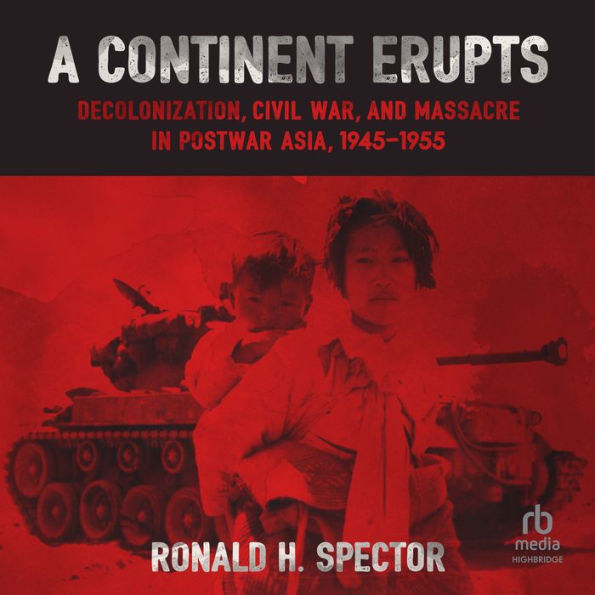Publishers Weekly
★ 08/01/2022
Historian Spector (In the Ruins of Empire) examines in this authoritative and often enthralling account how East and Southeast Asia became “by far the most violent region of the globe” in the decade after WWII. Drawing on multilingual sources from China, Korea, Vietnam, and elsewhere, Spector details how Allied leaders sought to reassert control over their prewar territories in massive military campaigns that were animated by Cold War rivalries and often devolved into savage civil wars between indigenous groups “who held vastly different visions of their nation’s postcolonial future.” This process began in September 1945, just weeks after Japan’s surrender, with the Dutch in Indonesia, the French in Indochina, Chiang Kai-shek’s Nationalists in China, and the Americans in Korea confronting local insurgencies empowered by the humiliating collapse of colonial regimes under Japanese attack. Spector provides comprehensive and captivating accounts of clashes less familiar to American readers, including the “Dutch Dien Bien Phu” in Java and the Chinese civil war’s Huaihai Campaign, which Mao Zedong called “China’s Gettysburg.” Vivid profiles of military and political leaders and luminous accounts of the French Foreign Legion versus the Viet Minh in Indochina and U.S. Marines against Chinese “volunteers” in Korea keep the pages turning, despite the wealth of detail. This sweeping survey of the bloody wages of decolonization astounds. (Aug.)
Sheila Miyoshi Jager
"Marvelous.... [Spector] does an excellent job of bringing alive this unruly and complicated story of postwar Asia.... [His] gripping book reveals the underlying motivations of these civil wars. In doing so, he helps us to understand why the legacy of these conflicts is still with us today."
History Today - Christopher Goscha
"Excellent.... A Continent Erupts reveals how the complex interaction of these various conflicts explains why the Asian continent did not enjoy much peace in the decade following the Second World War."
Wall Street Journal - Tunku Varadarajan
"Rich with battle detail.... There is engrossing color in Mr. Spector’s accounts."
Robert Dallek
"Ronald H. Spector’s history of post–World War II Asia fills a major gap in our understanding of the post-1945 world. His beautifully written narrative is essential reading for anyone who wants to understand how we arrived at current international conditions."
New York Times Book Review
Marvelous.”
Wall Street Journal
Rich with battle detail.”
Library Journal
03/01/2022
A Samuel Eliot Morison Prize-winning military historian, Spector offers a comprehensive look at the fighting that unfurled from China, Indonesia, and Vietnam to Korea and Malaya after World War II ended. Significantly, almost all the countries of South, East, and Southeast Asia once colonized or conquered by European powers or Japan had achieved independence within a decade, and Spector aims to give readers a clearer understanding of how their stories connect.
Kirkus Reviews
2022-05-10
How a decade of violence in Asia laid the foundation for eventual stability.
In this meticulously researched and carefully rendered study of the region in the period between 1945 and 1955, military historian Spector examines the conflicts that engulfed nearly every country, resulting in untold deaths and misery. Before World War II, the European colonial powers had enforced stability, overturning old empires and drawing new maps. This system was upended by a period of Japanese domination, the end of which created a power vacuum, with many players rushing to fill it. The French and the Dutch tried to reassert themselves, but the colonial game was up. The British looked for an honorable way to withdraw while retaining an economic role, but their power was waning. In many nations, struggles against colonial rules morphed into civil wars: “Regional, religious, ethnic, and ideological differences turned out to be, in many cases, as potent as the desire for social justice and national emancipation or the struggle against racism and colonial exploitation.” Spector is wary of the view that the violence was a matter of Cold War proxies. “It might be more accurate,” he writes, “to say that the Cold War did not spread to Asia; it was invited in.” In fact, it is impossible to find a single definitive model, as the conflict ranged from the open warfare of Korea to the insurgency of the Malayan Emergency. China was in a class of its own for complexity and clashes. Gradually, the politics of the region stabilized, sometimes through compromises and sometimes through military victories. There would be more violence in the following decades—most notably, the Vietnam War—but by 1955, the political framework was largely established. Spector does an admirable job exploring the tumultuous events of his large canvas, and he is willing to look past the headlines for the underlying reasons, motivations, and dynamics of each conflict.
An excellent starting point for anyone who wants to understand modern Asian history.



